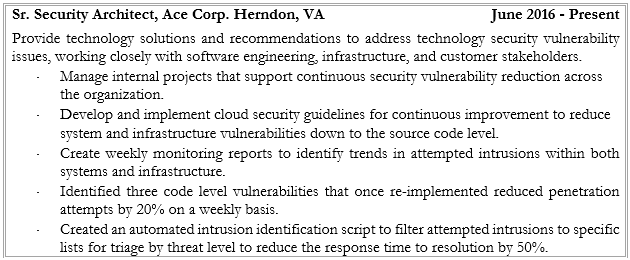
As a valued partner to the US Intelligence Community, we look out for the best and brightest talent to help us enable the world’s most advanced national security missions. Many of our team members come from our customer community and have dedicated their entire careers to ensuring our nation’s security. So what do you need to do make the grade and make a good impression on our recruiters? Read on to have all your resume questions answered.
1. Where should I show my security clearance on my resume?
Display your security clearance (or a note to ask about clearance) at the top center of your resume directly below name and contact information. Some candidates bury security clearances within a summary or somewhere towards the end of a resume which could lead to recruiters or hiring managers rejecting their candidacy.
Below is an example of how to build the top section of your resume. Include a common job title, your city, and state, as well as an email address and phone number. It isn’t necessary to include your entire home mailing address. If you’re uploading your resume to apply to a known defense employer site, it’s advisable to add your clearance and poly or polygraph, if applicable. If you’re uncomfortable displaying your security clearance, you can add “US Security Clearance, ask for details.”

2. How should I display my education?
Education, including both degrees and certifications, should be displayed before employment history as both could be required for certain defense contracts. Include degree level, year of obtaining, program name, and school name so recruiters or hiring managers can easily verify ABET status for the degree and program. Additionally, all IT administrator level staff in the defense industry must abide by DoD 8570 which requires all administrators must be IAT Level II certified. The default 8570 IAT Level II certification is CompTIA Security+. If a degree is less relevant for a particular career path, it can be moved to the end of a resume.
Below is an example showing a degree as well as relevant certifications for an industry professional.

3. What type of technical skills summary should I include—and where?
A technical skills summary should always come before work history. IT and engineering hiring managers are looking for operating systems, command line tools, scripting languages, and product or framework names. Many engineering and IT groups today use an abundance of different tools and products within the infrastructure to build custom tools and make things run more efficiently.
Below are two different ways to display technical skills summaries on a resume.
One strategy is to display a keyword group. This strategy is most often used to save space on a resume and is a good option if your technical skills summary is long.

A second strategy is to parse out each skill into categories such as operating systems, scripting languages and frameworks, services, or other tools.

4. How should my work history be presented on my resume?
Include job title, company name, location, and months and years of employment. Provide a summary of the position at the top to describe the general work, then add specific task-oriented bullets as well as two or three performance-based bullets. A performance-based bullet gives recruiters and hiring managers a quick glimpse into your potential value add to their organization prior to having an initial call. Performance-based bullets should not be several paragraphs long, rather a quick short example of an accomplishment describing the positive outcome.

5. Which fonts or designs do you recommend?
There are beautiful resume design templates available online today that can help candidates put their best foot forward and quick, however resumes with boxes, lines and pictures could come back out of an application system nearly unrecognizable. This is particularly common for defense contractor employers as often these organizations use older systems proven to be more secure for protecting candidate information with clearances. If you’re forwarding a resume via email directly to a hiring manager or recruiter as an attached PDF the likelihood of the document looking the same through email is high, but some application systems pull text from documents and parse them into fields when you complete the job application. Once beautiful resumes are nearly impossible for recruiters to read. A better method to brighten a resume and make the reader more engaged is to use a more desirable font. Use fonts such as Garamond, Calisto MT, or Cambria that have a slightly soft curl versus straight edged fonts like Times or Arial. As someone who personally reads resumes all day long, the softer curly fonts are far easier on the eyes.
Below is a side-by-side comparison of a slightly curly font, Garamond, versus a more straight, flat font, Times.
Garamond font:

Times font:

6. Where and how should I communicate my military service?
A great place to show your military is service is within your executive summary. It’s no surprise that defense companies hire military veterans as many professionals earn a security clearance throughout their time in service. It’s not only great for hiring professionals with clearances, but also highly motivated team-oriented people who are goal oriented. Companies today understand military veterans bring a unique value perspective that civilian professionals do not.
Below is an example of how to intertwine your military veteran status into your resume summary to market yourself as a military veteran.

7. Should I include my military or other educational awards on my resume? If so, where?
Every employer wants to see awards and recognition as it’s clear proof of positive performance. Some awards could be particularly relevant to your career goals and if that’s true, include those on the first page. If you earned such a significant number of military awards that listing all of them on page one would take up half of the page, pick and choose those most relevant to your target profession, then move the rest to the end of the resume. Don’t be afraid to go to two or three pages. If you only have 3-5 years of experience, a three-page resume could be overkill, but if you spent 20 years in the military and another 10 in corporate defense contracting, you may need to go to a third page—and that’s ok.
Lastly, when you have a draft ready of your resume, send it to friends and family to read and review. Have them read it aloud to try and catch and grammatical or spelling errors and re-read it aloud to yourself too once you get their feedback. It does not hurt to have additional eyes to help catch to, too, and two. Although desktop publishing software today does catch many grammatical and spelling errors, it won’t catch everything.
Want to help us enable the world’s most advanced security missions? We’re hiring technical professionals with US security clearance. Explore our career opportunities and create the future with us.
